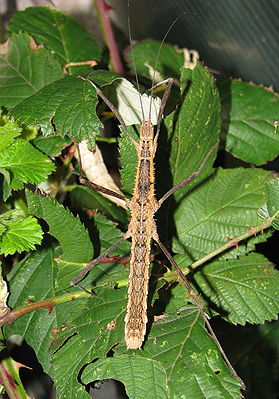Carpet insect
| Carpet insect | ||||||||||||
|---|---|---|---|---|---|---|---|---|---|---|---|---|

Female of the carpet insect ( Neohirasea maerens ) |
||||||||||||
| Systematics | ||||||||||||
|
||||||||||||
| Scientific name | ||||||||||||
| Neohirasea maerens | ||||||||||||
| ( Brunner von Wattenwyl , 1907) | ||||||||||||
| Subspecies | ||||||||||||
|
The carpet-cricket ( Neohirasea maerens ) is a kind from the order of the stick insects (Phasmatodea). Sometimes it is also referred to as the carpet stick insect or Märens stick insect . In the English-speaking world they are called "Vietnam Prickly Stick Insect".
features
In this wingless species, the females reach a length of 75 to 90 millimeters, the slimmer males remain significantly smaller at 57 to 65 millimeters.
The upper side of the body is lively beige and mottled light to dark brown. The darker parts form a wide strip which runs over the entire back ( chest and abdomen ) of the animals and is more prominent in the males. On this stripe there are many black spines on the top of the chest and the anterior abdominal segments. Next to it, on the edges of the body, there are also spines that are mostly beige. The males have fewer, but slightly longer thorns. There is also a dark stripe on the sides of the body, which is slightly narrower than the one on the back. The underside is beige with a few dark speckles. The legs of the adults are marbled in dark brown.
Occurrence and way of life
The carpet insect comes from Vietnam .
The animals spend their entire life on the food plants. In the event of danger, the nymphs can defend themselves by excreting an aromatic defensive secretion , which is harmless, but whose scent persists for a long time.
Reproduction
Carpet terrors can reproduce parthenogenetically in the absence of males . The females simply drop the spherical eggs, about two millimeters in diameter and only three milligrams in weight, to the ground. The nine millimeter long nymphs hatch from these after about four months. These are initially light brown and have strikingly light antennae ends . After each moult, they resemble the adult carpet terrors more. The older nymphs show a particularly lively drawing, occasionally even with reddish-brown coloring and always black knees.
Systematics
The carpet insect was described by Brunner von Wattenwyl in 1907 under the name Menexenus maerens . The female selected by Hausleithner in 1992 as a hololectotype is deposited in the Natural History Museum Vienna . In 2018, Ho described a subspecies from the Na-Hang nature reserve under the name Neohirasea maerens pseudomaerens . Their male holotype is deposited at the Manchester Museum .
Terrariums
The carpet insect was introduced to Europe from the Vietnamese national park Cúc Phương in 1995 and has been very popular in terrarium keeping ever since .
It is very easy to keep as the species can be successfully reproduced at room temperature and a humidity of 70 percent. The rose plants and especially the leaves of blackberries are suitable as fodder plants . When feeding roses whose origin is unknown, there is a risk that the animals will poison themselves with insecticides . Alternatively, ivy can also be fed.
The species is listed by the Phasmid Study Group under PSG number 173.
photos
Web links
- www. phasmiden.foren-city.de - Phasmidenforum: Description and keeping tips
Individual evidence
- ^ A b Paul D. Brock : Phasmida Species File Online . Version 5.0 / 5.0. (accessed on November 16, 2018)
- ↑ a b Christoph Seiler, Sven Bradler & Rainer Koch: Phasmids - care and breeding of ghost horrors, stick insects and walking leaves in the terrarium - bede, Ruhmannsfelden 2000, ISBN 3-933646-89-8
- ↑ a b c Ingo Fritzsche : Poles - Carausius, Sipyloidea & Co. - Natur und Tier Verlag, Münster 2007, ISBN 978-3-937285-84-9
- ↑ a b Carpet horror side of the phasmid world
- ↑ Species description of the Phasmid Study Group
- ↑ Phasmid Study Group Culture List ( Memento from December 5, 2012 in the web archive archive.today ) (English)




